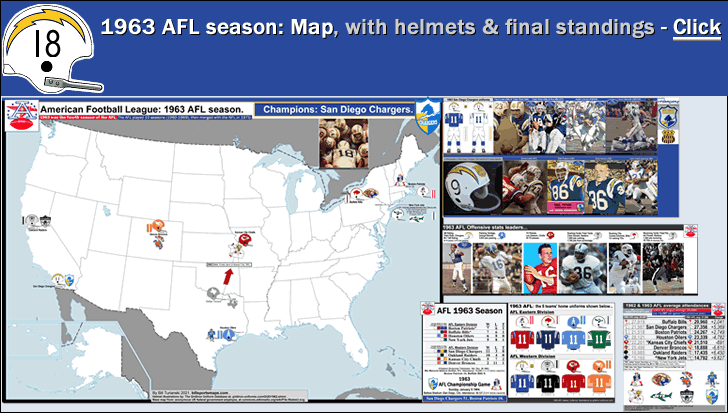
American Football League: 1963 AFL season, map with helmets/jerseys & final standings + offensive stats leaders; champions: San Diego Chargers
…
…
By Bill Turianski on the 31st of January 2021; twitter.com/billsportsmaps.
Links…
-1963 AFL season;
-1963 AFL Championship Game (en.wikipedia.org).
-1963 AFL season (pro-football-reference.com).
-1963 AFL uniforms (gridiron-uniforms.com).
The map… The map shows the primary helmets and jerseys worn by the 8 teams in the 1963 AFL, the fourth season of the American Football League. Also shown on the map page are the final standings of the 1963 AFL season, the Offensive leaders of the 1963 AFL season, and the average attendances of the 1963 AFL season (compared to the previous season).
…
- Changes in AFL franchises in 1963. One team moved to new city and changed their name (Kansas City Chiefs); one team changed their name (New York Jets). Both these revamped franchises became instrumental in the ultimate success of the AFL, in its battle with the NFL…
-Kansas City Chiefs, est. 1963…Right after winning the 1962 AFL title, the Dallas Texans (AFL, 1960-62) moved 453 miles (731 km) north, to Kansas City, Missouri. The franchise did this to avoid the situation in Dallas, Texas, where the team was competing with the much-stronger NFL in the form of the Dallas Cowboys. It was becoming obvious to owner-and-AFL-cofounder Lamar Hunt that the Dallas Texans were going to lose the battle for fans and ticket-support, there in Dallas, Texas. So the team moved to Kansas City, Missouri, and became the Kansas City Chiefs. Three years later, in the 1966 AFL season, the Kansas City Chiefs would play in the first Super Bowl (losing heavily to the NFL’s Green Bay Packers). Six years later, in the 1969 AFL season, the Kansas City Chiefs would upset the NFL’s Minnesota Vikings to win the fourth and final meeting between the AFL and NFL champions, in Super Bowl IV [4]. The 10-team AFL and the 16-team NFL would then merge for the 1970 season to form a 26-team NFL.
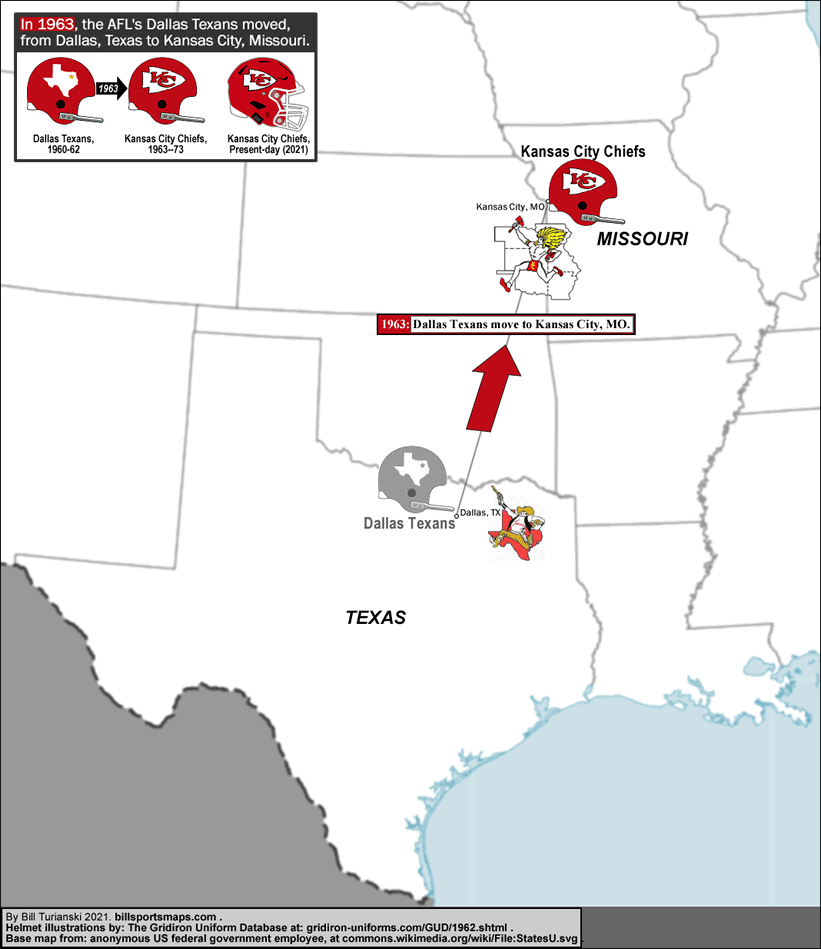
Image credits above – Blank map by anonymous US federal government employee, at File:StatesU.svg (commons.wikimedia.org). Helmet illustrations by The Gridiron Uniforms Database at gridiron-uniforms.com.
…
…
-New York Jets, est. 1963…The hapless and broke and bankrupt New York Titans AFL franchise was bought by a much deeper-pocketed consortium, headed by entertainment executive Sonny Werblin. The team changed its name to the New York Jets. The team also changed their colors – from navy-blue & yellow-gold, to green & white. Werblin’s first order of business was to sign as head coach and GM the former Baltimore Colts title-winning head coach Weeb Ewbank, who said “I don’t see why we can’t build a winner here in five years.” The franchise finally was able to set in motion their plans to move out of the decrepit and soon-to-be-demolished Polo Grounds (on the tip of northern Manhattan, NYC), and into the new multi-purpose stadium being built by the government of New York City, in Queens, NYC. The move to the new venue would happen the following season of 1964, and attendance would skyrocket. The Jets’ improved on-field record coincided with their huge attendance increase at Shea Stadium, there in Queens, with QB Joe Namath at the helm. Five years after the name-change from the Titans to the Jets, in the 1968 season, the Jets were AFL champions. And so the AFL’s New York Jets then faced the NFL’s Baltimore Colts in Super Bowl III [3]. The hugely-favored Colts were beaten by the Jets, in one of the biggest upsets in pro football history, thereby signifying to the American public that the AFL had arrived, and was the equal of the NFL. Two seasons later (in 1970), the two leagues would merge.
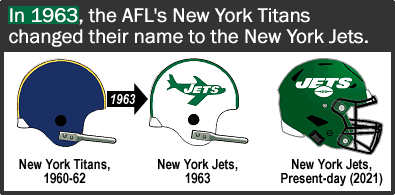
Image credits above – Helmet illustrations by The Gridiron Uniforms Database at gridiron-uniforms.com.
…
AFL attendances in 1963…
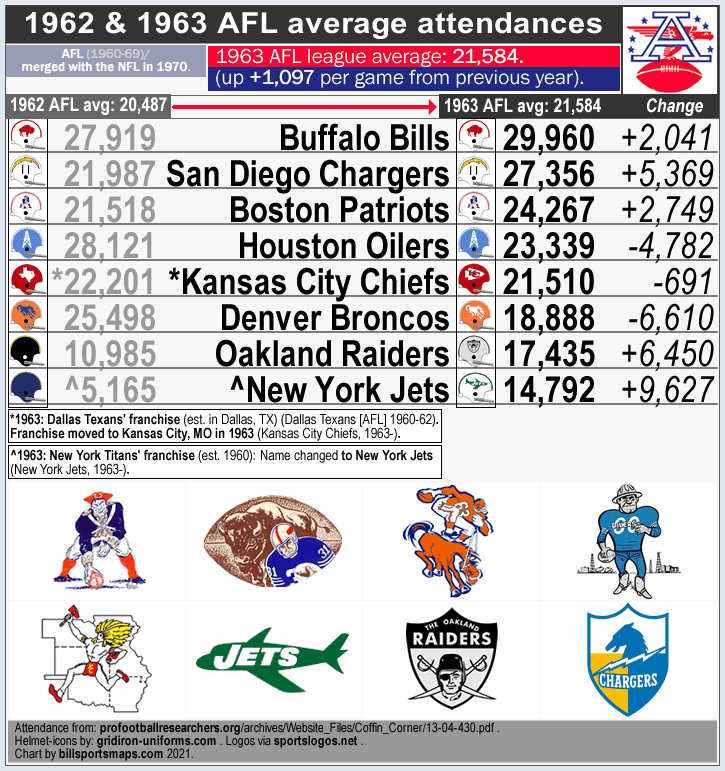
Source for attendance figures: pdf at ProFootballResearchers.org [Coffin Corner newsletter, Sept 1991, by Bob Carroll], profootballresearchers.org/archives/Website_Files/Coffin_Corner/13-04-430.pdf. Helmet illustrations from gridiron-uniforms.com.
…
Average Attendance, NFL vs. AFL (the 10 years they were in competition: 1960-69); plus NFL/AFL/Super Bowl title-winners in the 1960s…
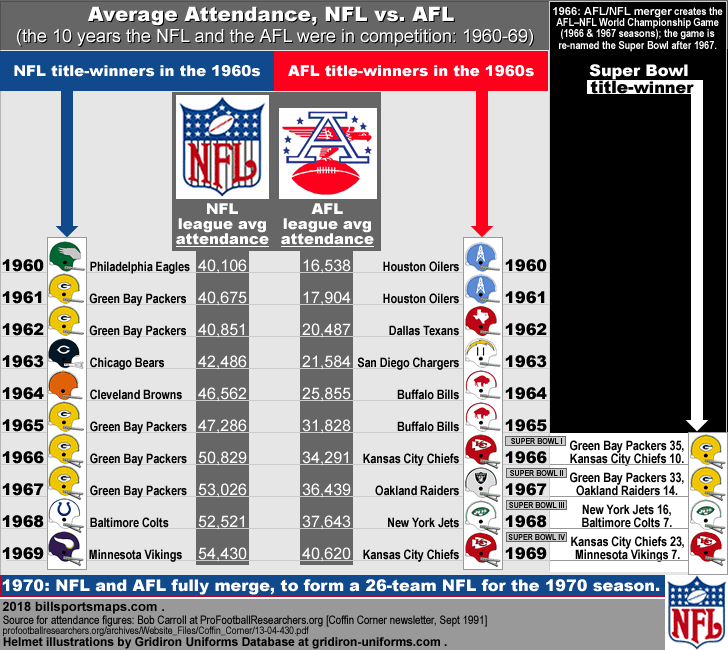
Source for attendance figures: pdf at ProFootballResearchers.org [Coffin Corner newsletter, Sept 1991, by Bob Carroll], profootballresearchers.org/archives/Website_Files/Coffin_Corner/13-04-430.pdf. Helmet illustrations from gridiron-uniforms.com.
…
…
- 1963 AFL champions – the San Diego Chargers
The San Diego Chargers were one of the strongest teams in the ten seasons of the AFL (1960-69). Yet although they made it to 5 AFL title games, the Chargers won only one of them – in 1963, when they blew out the Boston Patriots by 41 points.
It all came together for head coach Sid Gillman’s San Diego Chargers in 1963. 1962 had been a bust for the Chargers (who went an abysmal 4-10). But the team regrouped, after a boot-camp type atmosphere at their ’63 training camp, out in the high desert east of San Diego. Then the Chargers cruised through the 1963 regular season with the AFL’s best record (11-3), beating out the surprise Al Davis-led Oakland Raiders, by one game to win the Western Division. Led by the AFL’s 1963 MVP Tobin Rote (at QB), and future Hall-of-Famer WR Lance Alworth, the Chargers averaged 28.5 points per game, and were the highest-scoring offense in the league. And the tough Chargers defense allowed the least amount of points that year {1963 AFL standings}.
Then the Chargers caught a break. Because the Eastern Division had no clear dominant team, and the East was deadlocked at the top with two 7-6-1 teams. And so that meant that the East had to be decided by an extra playoff game (the AFL had no tiebreakers). And when the Boston Patriots beat the Buffalo Bills in that extra game, to advance to the 1963 AFL title game, the Patriots were depleted by the effort. So the Chargers entered the ’63 title game well rested, while the Patriots were anything but that.
Sid Gillman, renowned for his forward-thinking and pass-oriented “vertical offense”, decided to change things up for the 1963 title match. The Chargers had been beaten by a strong defense in the 1960 and 1961 AFL title games (both times losing to the Houston Oilers). With that in mind, Gillman drastically changed their plan of attack for the ’63 title game. Instead of deep routes to WR Lance Alworth, the Chargers would go with swing passes to FB Keith Lincoln. And instead of runs behind their future Hall of Fame OT Ron Mix, the Chargers would go with draws (to Lincoln and to HB Paul Lowe), and misdirection plays. In other words, Gillman was going with the opposite of what the Chargers had become known for.
By the time the Boston Patriots caught on to the Chargers’ game plan, the damage was done. Powered by long TD-runs by Keith Lincoln (for 67 yards) and Paul Lowe (for 58 yards), the Chargers shot out to a 21-7 lead after the 1st quarter. And the Chargers led by 31-10 at halftime. By the start of the 4th quarter, San Diego led by 28 points, and backup-QB John Hadl replaced Tobin Rote. 13 points later, the score was 51-10, and the Chargers were the new AFL champions.
MVP honors went to Keith Lincoln. Keith Lincoln was a QB out of Washington State, who had been drafted in the 5th round of the 1961 NFL draft by the Chicago Bears. But Lincoln, who grew up in southern California, decided to sign with the AFL’s San Diego Chargers instead. There he was converted to a running back. Lincoln had the game of a lifetime in the 1963 AFL title game, racking up an astounding 329 yards from scrimmage (206 yards rushing and 123 yards receiving). Plus he threw one pass for a 20-yard gain. The 329 yards from scrimmage that Keith Lincoln produced that day in San Diego has never been bested in a pro football title game, and is tied for 3rd-best all-time [NFL, 1920-2020; AFL, 1960-69]. {All-time best yards-from-scrimmage in a game (pro-football-reference.com/leaders).}
As of 2020, the Chargers have not won another title.

Photo and Image credits above – Tobin Rote & Ron Mix in the 1963 AFL Championship Game, unattributed at pinterest.com. Keith Lincoln runs for a 67-yard TD in the 1963 AFL Championship Game, photo unattributed at profootballtalk.nbcsports.com. Paul Lowe runs for a 58-yard TD in the 1963 AFL Championship Game, photo by Charles Aqua Viva/Getty Images via boltsfromtheblue.com. Lance Alworth catching long pass in the 1963 AFL Championship Game, photo unattributed at goldenrankings.com/AFLchampionship1963. Keith Lincoln taking hand-off from backup-QB John Hadl, late in the 1963 AFL Championship Game, unattributed at pinterest.com. Keith Lincoln on sidelines [circa 1964], photo unattributed at alchetron.com. San Diego Chargers 1963 helmet, from helmet hut.com. Head coach Sid Gilman and the Chargers players and staff celebrate the teams first (and only) championship title, with a champagne toast, photo unattributed at goldenrankings.com/AFLchampionship1963.
…
…
San Diego Chargers on map page… 1963 Chargers’ offense in the huddle listening to QB Tobin Rote (#18), unattributed at pinterest.com. 1963 Chargers uniforms, illustrations by Gridiron Uniforms database at gridiron-uniforms.com/[1963-AFL]. Tobin Rote & Paul Lowe [photo from 1963 Sports Illustrated cover], photo by Walter Iooss, Jr./Getty Images via pinterest.com. Tobin Rote & Ron Mix [photo from 1963 AFL Championship Game], unattributed at pinterest.com. Keith Lincoln [photo from 1963 AFL Championship Game], unattributed at pinterest.com. Lance Alworth [photo from 1963], photo by Focus On Sport/Getty Images via gettyimages.ca. San Diego Chargers 1963 helmet, from helmet hut.com. Ernie Ladd [photo from 1963], unattributed at bleacherreport.com. Earl Faison [1962 Fleer card], from psacard.com. Dick Harris [1962 Fleer card], from amazon.com. John Hadl [photo from 1965], photo by Neil Leifer/Getty Images via gettyimages.com. Chargers patch circa 1960s from ebay.com.
Offensive stats leaders on map page… Tobin Rote (Chargers) [photo from 1964], unattributed at talesfromtheamericanfootballleague.com. George Blanda (Oilers) [photo circa 1964], unattributed at pinterest.com. Len Dawson (Chiefs) [1964 Topps card], from cardboardconnection.com. Clem Daniels (Raiders) [photo circa 1964], photo from raiders.com. Cookie Gilchrist (Bills) [photo from 1964], unattributed at pinterest.ie. Art Powell (Raiders) [photo circa 1965], unattributed at fs64sports.blogspot.com.
…
Thanks to all at the following links…
-Blank map by anonymous US federal government employee, at File:StatesU.svg (commons.wikimedia.org).
-Thanks to Sportslogos.net for 1960-era AFL team logos.
-Thanks to the contributors at pro-football-reference.com.
-Thanks to the contributors at AFL 1963 season (en.wikipedia.org).
-Thanks to the Coffin Corner newsletter, for this pdf, profootballresearchers.org/archives/Website_Files/Coffin_Corner/13-04-430.pdf [AFL attendance by team 1960-69] .
Special thanks to Tim Brulia, Bill Schaefer and Rob Holecko of The Gridiron Uniform Database, for giving billsportsmaps.com the permission to use football uniforms illustrations from Gridiron Uniform Database {GUD}.
